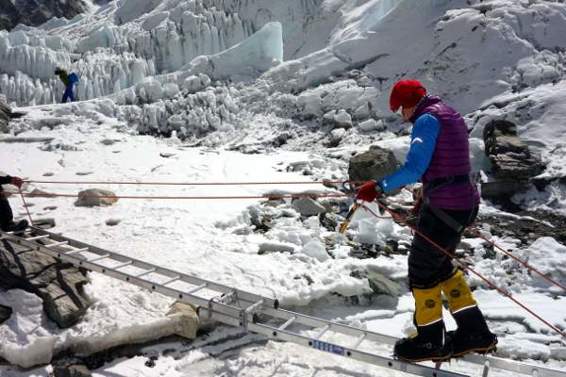
Monday, 14 April 2014 – Everest Base Camp, Nepal

I have another good night’s sleep and feel like I’m starting to get over my little illness. As I get ready for eight o’clock breakfast I go for a pee, and see Phil, Dorje and Ang Gelu fixing two ladders over a stream below camp. They are making preparations for a ladder training session after breakfast. Ang Gelu was meant to be carrying a fifteen-kilogram load up the Khumbu Icefall this morning. I conclude that Margaret must have won her argument with Phil.
You may wonder why such a training session is necessary. Any fool can climb a ladder, after all. But speed is of the essence when moving through the treacherous terrain of the Khumbu Icefall. It’s not so easy to climb a series of ladders strapped together, that flex beneath you as you stare into a yawning crevasse. Crampons don’t make it any easier. There are ropes on either side to act as handrails, and there’s a certain technique to keeping them taut as you cross. You have to clip in and out of them at each anchor point. Climbers who have not mastered these techniques keep everyone waiting as they edge across nervously, or fumble with their carabiner as they clip in and out of the rope. With towers of ice that threaten to collapse, snow bridges in danger of melting, and regular avalanches from the mountains on either side, the Khumbu Icefall is not a place to linger for too long.
After breakfast we unpack our boots, crampons and harness/jumar rigs, and go onto the ice. The training is straightforward. We cross a pair of horizontal ladders, climb a pair of vertical ladders tied together, then traverse back down again. I haven’t had much practice crossing ladders while wearing crampons, so it’s a good confidence booster for me.

Ladder practice on the Khumbu Glacier
Ricardo seems as healthy as the rest of us, but after lunch he tells us he needs to have his blood pressure checked at the Himalayan Rescue Association (HRA) medical facility at the other end of camp. The HRA is a charity founded in the 1970s with the aim of reducing illness in the mountains of Nepal. Since 2003 it has maintained a temporary health clinic at Everest Base Camp during the climbing season, staffed entirely by volunteer doctors and nurses. It’s known affectionately as Everest ER, and we’ve all paid a contribution this year to make use of its services should we need them.
Ricardo seems to be popular with the ladies (as most musicians are), and has therefore acquired the reputation as the team Casanova. When he announces that he’ll be visiting the hospital, it’s the signal for more ribald humour.
‘Are you sure you’re ill, Ricardo, or are you just going to check the nurses out?’
‘If you’re looking to raise your blood pressure, you can save yourself a walk. Robert has some Viagra.’
It snows for most of the afternoon. The sky remains overcast, but just before dinner the clouds lift, providing our mountain amphitheatre with a vast open roof. This makes for a bitterly cold evening, but it also gives us a few moments to contemplate the panorama all around us. The sun touches Changtse on the Tibetan side of the Lho La, bathing the rocks in an orange glow. Then it falls from the sky and plunges us into darkness.